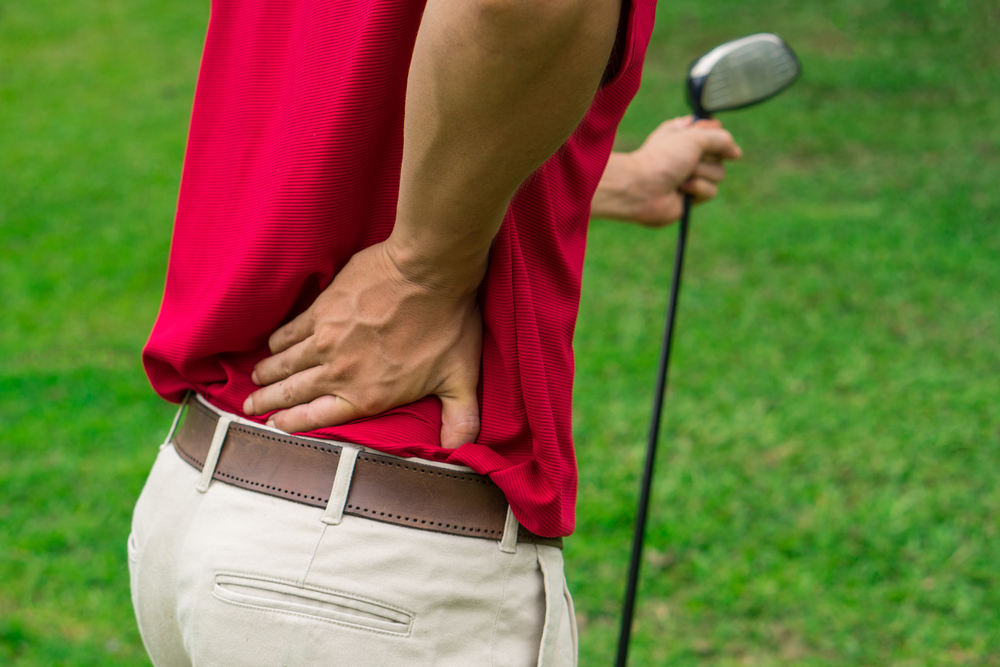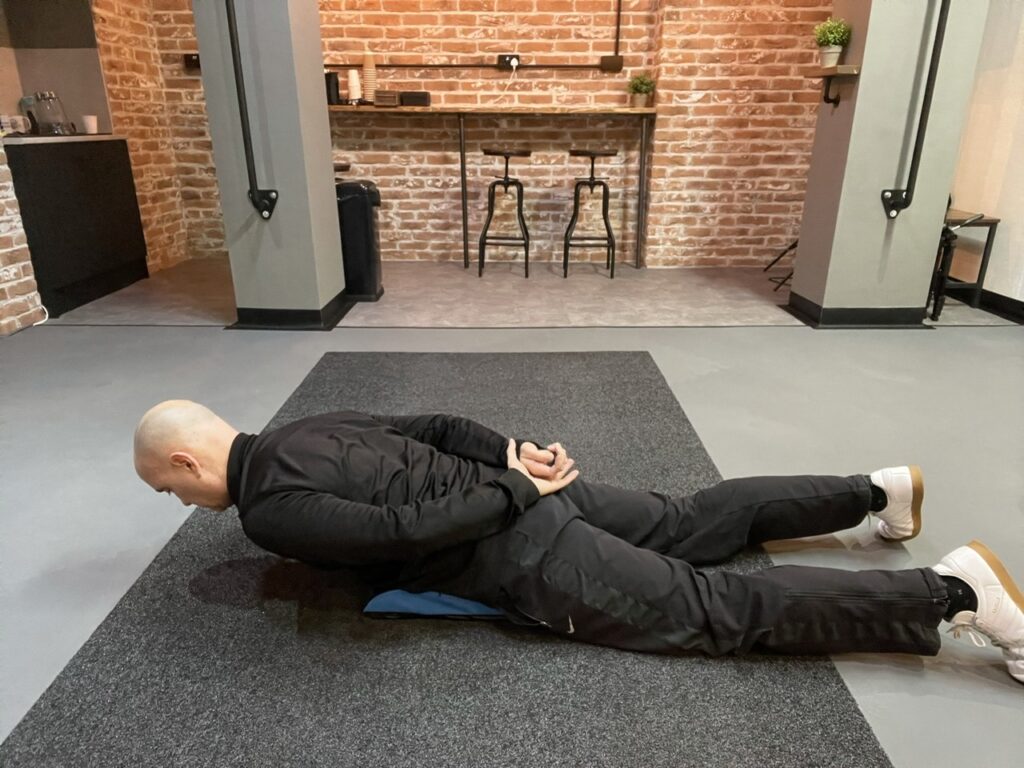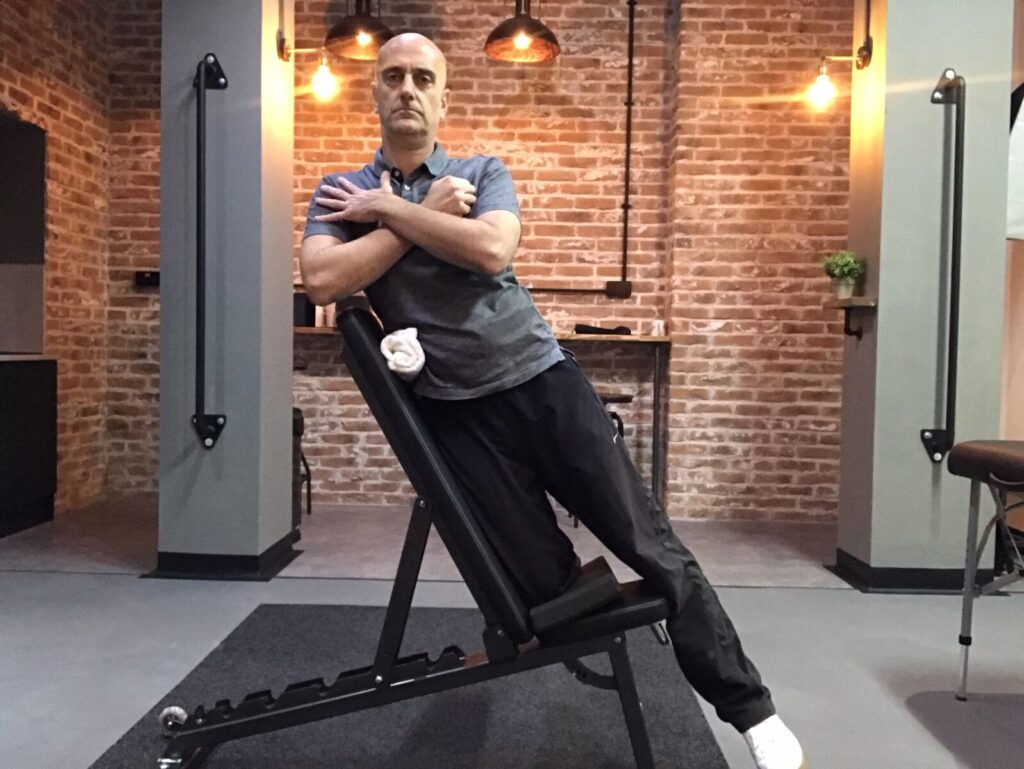In this post we take a detailed look at what causes back pain from golf and what you can do to prevent it.

Here’s an interesting statistic for you, if you play golf there’s a 1 in 3 chance you will suffer with back pain as a result.
Many of the golfers I speak to seem to accept that back pain is just part of the game. Some tell me they consider packing anti-inflammatories as important as packing their clubs.
It doesn’t have to be like this.
In this detailed post we look at why golf can cause back pain and 3 evidenced based exercises to help you prevent it.
Why your back hurts after playing golf
We can probably agree that the golf swing itself is the most physically demanding aspect of the game. The evidence bears this out.
The compressive loads on your spine during the swing are equivalent to 8 times your body weight.
That’s a bunch.
Think about a line backer slamming into a training sled and you’re close to the mark.
As every injury is related to your body’s ability to tolerate the forces that are being applied to it, this may explain why the golf swing can lead to problems.
Studies have shown the more frequently you play, the greater the risk you’ll experience issues.
The fact you are more likely to provoke a painful episode on the driving range is proof of this. The absolute number of swings in a shorter time frame being the key factor here.
So if both the forces involved in the swing, and the number of swings taken are contributing factors, that suggests the muscular system may play a role.
Trunk strength and endurance in golfers with back pain
A number of studies have investigated what’s different about golfers with back pain.
In a 2013 study researchers compared trunk rotational strength and endurance in golfers with and without back pain.
They found both groups had more rotational strength in the direction they swung the club. No surprise there perhaps.
The larger the difference in strength between left and right however, the more likely the golfers were to suffer from back pain.
A large scale survey of 283 professional Japanese golfers also noted some similarities in those with back pain. Sugaya et al found that lower back pain occured more frequently on the right hand side of the spine in right handed golfers.
Follow up imaging seemed to confirm this. Scans showed a higher rate of arthritic changes in the vertebral bodies and facet joints on the right hand side of the spine compared to the left.
In a prospective study Evans et al followed a group of Australian golfers as they trained to become professionals.
None had back pain at the start of the study, but those who went on to develop it had two things in common:
1) A body mass index (BMI) of 25 plus.
2) An inability to hold a side plank on their right hand side for longer than 12.5 seconds.
It’s also been shown that golfers with back pain have reduced trunk extension endurance compared with healthy controls.
Interestingly, the study above also noted weakness in the quadricep muscles of golfers who had a history of back pain.
Trunk rotation range of motion in golfers with back pain
I meet plenty of golfers who are obsessed with increasing their ability to rotate their trunk.
Ever since the X factor term was coined in the 90s, golfers have been attempting to twist themselves into positions of greater trunk rotation. All with the hope of generating more power in their swing.
A recent paper in the Journal of Neurosurgery has suggested the modern swing may be responsible for the uptick in golfers with back issues. Tiger Woods being the obvious example.
The authors surmise that both the extreme rotation and the side flexion element of this swing may lead to disc injuries over time.
Research does show how far you can rotate your trunk might be important in preventing lower back pain, but not necessarily in the way you think.
Lindsay and Horton found that golfers who experienced back pain were more likely to produce greater amounts of rotation during their swing than they could produce under controlled circumstances in the clinic.
In other words they were breaching their range of motion limits using momentum.
In addition, it’s been shown that reducing range of motion can eliminate back pain in certain cases.
Perhaps the most important conclusion here is that adapting your swing to meet your current range of motion limitations is a wise move.
More on how to safely increase those range of motion limitations in a moment.
Other factors that contribute to back pain in golfers
Whilst researchers have focused their attention on differences in the muscles of the trunk, some have looked elsewhere. Most notably the hips.
Vad et al examined motion in the hips of 42 professional golfers attending a PGA Tour event.
Those who suffered with lower back pain (14) had significant restrictions in both internal and external rotation of the lead hip, as well as in extension of the lumbar spine.
The authors suggest this might result in overload of the trunk muscles as they attempt to compensate for this lack of motion elsewhere.
Putting it all together
It’s always difficult to make individual recommendations from research. Protocols that will work for everybody don’t exist due to individual differences.
It does seem however that there are some common themes from the studies that have been carried out so far.
- Trunk rotation strength asymmetry.
- Lack of endurance in the muscles that side bend the trunk.
- Poor endurance in the spinal extensors.
- Restrictions in trunk range of motion.
- Lack of internal and external rotation in the lead hip.
With the evidence in mind, let’s look at 3 exercises that will help prevent lower back pain from golf.
Trunk rotation strength exercise
You may be lucky enough to have a torso rotation machine in your gym. If you don’t, a cable machine like the one pictured above can be used to effectively challenge your trunk rotators.
Place a weight bench in between two cable stacks. Use Velcro cable attachments on each arm. Note the attachments are placed high on the arm to keep the contribution from the shoulders to a minimum.
Place a yoga block or similar between your knees to reduce motion at the pelvis.
Before your begin, check how much active trunk rotation you have by rotating your trunk first one way and then the other.
Make sure the resistance doesn’t take your further than this during the exercise. This is very important.
In the image above I am challenging the muscles that rotate my trunk to the left and I’m pictured in the mid range position of the exercise. To complete the repetition I’ll slowly rotate my trunk to the left before coming back to my limit of right trunk rotation.
To challenge the opposite side rotators, switch the cables to the opposite arms.
Train both sides slowly and deliberately to check if there’s a difference in strength. If you find one, train the weaker side first.
This exercise should cause no pain. If it does stop and re-evaluate the set up. Reduce the range you are working through and the resistance if necessary.
Aim for 1 set of around 6-10 repetitions to begin with.
Side bend strength exercise
Use a weight bench on an incline with a small towel placed between your ribcage and pelvis on the opposite side.
Slowly side bend away from the bench by bringing the lateral aspect of your ribcage down towards your pelvis as far as it will go. Hold for a second or two before slowly returning to the start position.
Continue until you feel fatigue in the muscles at the side of your abdomen. Decrease the incline of the bench to add difficulty.
Lumbar spine extension strength exercise

Use a Core Pad (pictured) for this exercise as it will allow your spine to move towards flexion and is stable. A pillow will suffice if you don’t have one available.
Keep your knees on the floor and your gluteus maximus (butt muscle) switched off to isolate your lumbar spine muscles as much as possible.
Extend your lumbar spine as far as you can before slowly curling your spine back around the pad.
Continue until you feel fatigue in your lumbar spine muscles.
Restrictions in trunk range of motion
This post will show you exactly how to check for and safely improve restrictions in trunk range of motion.
Limitations in lead hip rotation
Whilst this post will demonstrate how to check for and improve restrictions in lead hip motion.
Summary
Back pain is not an inevitable part of playing golf. If you’re currently experiencing issues, the chances are you will have some of the limitations described above.
A programme of targeted exercises to improve those limitations can help reduce your back pain, or eliminate it all together.
Not only will this be good for your long term health, it will also improve your gof.
If you’d like to explore the possibility of working with us, please see our Golf performance programme for more details.

